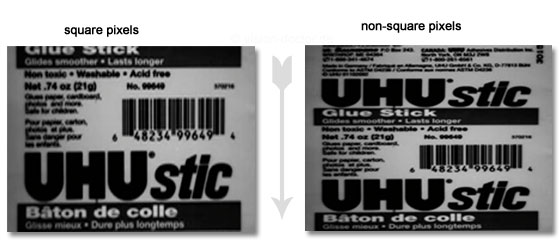Use of encoders
The use of incremental encoders is almost always stringently required when using line scan cameras. The aim is to synchronise the path covered and the pixel size. Only in this way the image will be free of distortion and have the same imaging scale in transport direction and across the conveyor.
|
Use of a rotary encoder
- A rotary motion generates pulses.
- Depending on the type, up to 32,000 pulses per revolution can be generated.
- Factors in the configuration software of the line scan camera or the image acquisition card serve to adjust how many encoder ticks are supposed to be one pixel.
- Programmable encoders are more flexible. In this case you can adjust which number of ticks is supposed to be one revolution and spare the subsequent conversion in the machine vision system environment.
- The signals are transmitted as differential or TTL signals. When selecting the encoder, please observe the interfaces of your image acquisition card or line scan camera.
Use of a linear encoder
- A contact-free reading head of a magnetic sensor generates pulses.
- An affixable magnetic tape at the reading distance of several millimetres represents the counterpart of the system.
- Depending on the type, up to 0.001 mm can be triggered.
- There are also programmable types which generate a definable number of ticks per distance.
- Differential or TTL signals can likewise be selected.
Principle of an encoder
 |
Normally an image should only be captured during the forward motion of the conveyor. If a conveyor, however, is stopped again and again, it can happen that it moves a little backwards. Here, too, the use of an encoder can help: the direction of motion can be determined from the sequence of the encoder signals:
 |
Good line scan camera products are able to count these backwards steps and only start the image capture again when the counter is set back to zero during the next forward motion.
Typical problems with encoders
If the image is too dark, the exposure time per line of the camera is often prolonged. From a certain value on, however, the image appears distorted in transport direction although the encoder is supposed to avoid this effect.
The reason for this phenomenon is that the exposure time of the camera is longer than the encoder time, the system is virtually "over-triggered" and lines are missed in the image capture. These missing lines lead to image compressions. Example: in case of a typical line scan frequency of 18 kHz, i.e. 18,000 lines per second, 55 micro-seconds per line are maximally available for exposure!
Possible solutions
- Reduction of the conveyor speed.
- More light allows for shorter exposure times maintaining the same conveyor speed.
- The use of a better camera with larger sensor pixels or a dual-line or TDI sensor significantly enhances the sensitivity to light.
- Use of particularly wide-aperture lens








